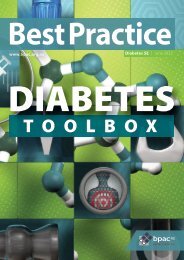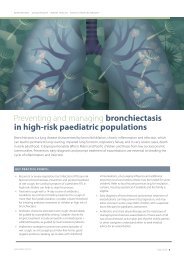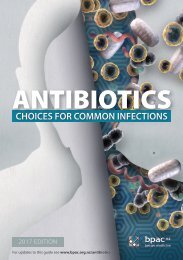You also want an ePaper? Increase the reach of your titles
YUMPU automatically turns print PDFs into web optimized ePapers that Google loves.
is worthwhile requesting a diagnostic test. The probability may<br />
change during the consultation as symptoms and signs are<br />
weighted as being “somewhat more suggestive” or “somewhat<br />
less suggestive” of the suspected medical condition.<br />
The sensitivity of a test is the proportion of people with the<br />
condition who have a “positive” result (above or below the<br />
diagnostic threshold used), i.e. the ability of the test to correctly<br />
identify patients with the condition. Because the number of<br />
false-negatives decreases as the sensitivity of the test increases,<br />
a highly sensitive test is useful for “ruling out” a condition if<br />
the patient tests negative. Highly sensitive tests are used when<br />
the consequences of missing a condition are potentially very<br />
serious, such as for an acute myocardial infarction.<br />
The specificity of a test is the proportion of people without the<br />
condition who have a “negative” result, i.e. the ability of the test<br />
to correctly identify patients without the condition. Because<br />
the number of false-positives decreases as the specificity of the<br />
test increases, a test with a high specificity is useful in “ruling<br />
in” a condition if a person tests positive. As with sensitivity,<br />
the specificity of a test will vary somewhat depending on the<br />
diagnostic threshold chosen.<br />
There are very few tests, if any, that have 100% sensitivity and<br />
specificity. The choice of what threshold is used depends on<br />
the parameters of the test and what the purpose is when using<br />
it. Deliberately setting the threshold for optimum sensitivity<br />
can result in increased numbers of false positives (above or<br />
below the threshold) as well, resulting in reduced specificity.<br />
Conversely, in other circumstances optimising specificity may<br />
be more relevant, at the cost of reduced sensitivity.<br />
Performing several tests serially increases the overall<br />
specificity for detecting a condition, with each test being<br />
sequentially more specific than the previous one.<br />
Positive predictive value is the probability that a patient with<br />
a positive test result really does have the condition for which<br />
the test was requested. Unlike sensitivity and specificity which<br />
are independent of the population being tested, the positive<br />
predictive value of a test changes depending on the prevalence<br />
of the disease in the population being tested.<br />
The negative predictive value is the probability that a patient<br />
with a negative test result really is free of the condition for<br />
which the test was conducted.<br />
The probability of an abnormal result increases when<br />
the number of tests increases<br />
The risk of a healthy individual having a result outside the<br />
reference interval increases as the number of tests selected<br />
increases. This is because the normal reference interval for most<br />
biochemical tests is defined as being two standard deviations<br />
from the mean of a healthy population. Therefore, an average<br />
of 5% of all test results from healthy patients will fall outside<br />
the normal range and be recorded as abnormal (Table 1). 7, 8<br />
False-positive results are more likely when people with a<br />
low probability of a condition undergo testing. Although false<br />
positive results can cause significant anxiety to the patient,<br />
false-negative results can often have more serious health<br />
consequences. Test results should always be interpreted in the<br />
context of other information gained from the clinical history<br />
and physical examination. Results which are borderline need<br />
to be interpreted with caution as the inter-test variability could<br />
mean the result is either normal or abnormal, so may need to be<br />
repeated after a period of time. If there is doubt, consultation<br />
with a pathologist about the test results can be helpful.<br />
Table 1: Probability of a healthy person returning an abnormal<br />
biochemical test result, adapted from Deyo (2002) 8<br />
Probability of at least one<br />
Number of tests<br />
abnormal test (%) *<br />
1 5<br />
6 26<br />
12 46<br />
20 64<br />
100 99.4<br />
* Assuming each test outcome is independent<br />
For the original and extended version of this article, see:<br />
“Best Tests?” (available from: https://bpac.org.nz/BT/2013/<br />
February/02_principles.aspx)<br />
References<br />
1 Srivastava S, Koay E, Borowsky A, et al. Cancer overdiagnosis: a biological<br />
challenge and clinical dilemma. Nat Rev Cancer 2019;19:349–58. doi:10.1038/<br />
s41568-019-0142-8<br />
2 Salmon P. The potentially somatizing effect of clinical consultation. CNS Spectr<br />
2006;11:190–200. doi:10.1017/s109285290001436x<br />
3 Song D, Palmer B, du Toit S, et al. Inappropriate trace element testing in the<br />
Auckland region. NZMJ 2010;123:24–34.<br />
4 Walker P, Crook M. Tumour marker requesting in primary care and the role of<br />
the laboratory. J Clin Pathol 2011;64:443–6. doi:10.1136/jcp.2010.085357<br />
5 Ministry of Health and Cancer Society of New Zealand. Consensus statement<br />
on vitamin D and sun exposure in New Zealand. 2012.http://www.health.govt.<br />
nz/system/files/documents/publications/vitamind-sun-exposure.pdf<br />
6 Hickner J, Graham D, Elder N, et al. Testing process errors and their harms<br />
and consequences reported from family medicine practices: a study of the<br />
American Academy of Family Physicians National Research Network. Qual Saf<br />
Health Care 2008;17:194–200. doi:10.1136/qshc.2006.021915.<br />
7 Whyte M, Kelly P. The normal range: it is not normal and it is not a range.<br />
Postgrad Med J 2018;94:613–6. doi:10.1136/postgradmedj-2018-135983<br />
8 Deyo R. Cascade effects of medical technology. Ann Rev Public Health<br />
2002;23:23–44. doi:10.1146/annurev.publhealth.23.092101.134534<br />
www.bpac.org.nz<br />
Best Practice Journal – SCE Issue 1 45









